
Vol. 5, No.9, September 2009 |
 Printer-Friendly PDF Version Printer-Friendly PDF Version |
Contents |
The No-Hurricane Year?
An "increased probability of a below-normal year ..."
An "increased probability of a below-normal year ..."

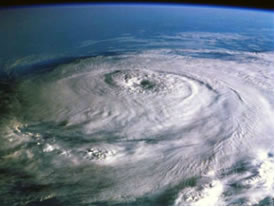
"According to its August Atlantic hurricane season outlook, NOAA now expects a near- to below-normal Atlantic hurricane season, as the calming effects of El Niño continue to develop. But scientists say the season's quiet start does not guarantee quiet times ahead. The season, which began June 1, is entering its historical peak period of August through October, when most storms form."
To read the complete article with a discussion of the effects of El Niño - which is in the Pacific Ocean, not the Atlantic - point your mouse at this web site and pull the trigger www.noaanews.noaa.gov/stories2009/20090806_hurricaneupdate.html.
Advisory Board Minutes and Next
Advisory Board Meeting
The Florida SART Advisory Board met on Wednesday, September 2, 2009 from 10:00 a.m. to Noon at the Florida Farm Bureau, 700 SW 34th St., Gainesville, FL 32608. Minutes are available at www.flsart.org/SART/memberdoc/minutes09-02-09.pdf.
Michael Turner presented a draft SART Standard Operations Guide (dated 9-02-09) and SART members may contact him at turnerm@doacs.state.fl.us. This document should be available within the next month, and should be posted on line once it is fully approved.

"UF's Joan Dusky (left) reviews development of the SART Internet site (www.flsart.org) with Michael Turner (ctr.) and web-master Jiannong Xin.

Laura Bevan (left) and Tim Manning discuss on-going SART training opportunities in an era when hurricane activity is low.
 Sign on US 90, Lee, FL.
Sign on US 90, Lee, FL.Next Advisory Board Meeting: The next SART Advisory Board meeting is tentatively scheduled for the end of the 2009 hurricane season at 10:00 a.m. December 2nd at the Farm Bureau building in Gainesville. Updates will be noted on the SART web site at www.flsart.org.
Animal Sheltering: Joe Kight, State ESF 17 Coordinator (kightj@doacs.state.fl.us), presented a draft "Emergency Animal Sheltering Policy" which he had worked on with Laura Bevan (lbevan@hsus.org) of HSUS and with input from many others. While quite a few legal and financial questions are involved in sheltering animals following an emergency, the issue can also become contentious and he solicited SART member comments and recommendations. It is important for local jurisdictions to have a policy, he says, and the Draft is a step forward; you can expect that it will be made public soon. Kight also noted that as a general rule FEMA would reimburse jurisdictions for holding animals until the last public shelter closed following a declared emergency.
Florida Animal Producer Guidance
For Routine Disposal of Animal Carcasses
Greg Christy, DVM, FDACS/DAI (christg@doacs.state.fl.us)
- Florida statute notes that upon death of domestic animals (livestock, horses, dogs, cats ...) due to disease, the carcass must be burned, buried (at least 2-feet down) or disposed-of with rendering company.
- For the death of domestic animals due to natural causes: rendering (preferred), deposit in landfills, composting or burial.
- Rendering: Conversion of carcass into meal, melted fat and water via grinding and drying.
- Off-Site Landfill: Class 1 landfills may accept carcasses.
- Composting: The preferred method of carcass disposal - Windrow Composting (producing compost by piling organic matter in long rows with other organic bulk materials and covered top and bottom; compost is monitored and periodically turned) and Hay Bale Bin Composting (carcasses layered with bulk materials inside "bins" whose sides are hay bales).
- 6. On-Site Burial: Water contamination a serious issue - Trench or Above-Ground (for areas with high water tables).
 Hay bale bin composting
Hay bale bin composting- Routine disposal - FDEP (850) 245-8706 or USDA/NRCS (352) 338-9555
- Unusual animal deaths or diseases - FDACS/DAI (850) 410-0900
- Communicable animal diseases - FDOH (850) 245-4250
- "Tipping fees:" Tipping fees are what a solid waste facility charges per dump or tip of a dump truck. Usually, this is so much $ per ton of dumped waste.
Wakulla County Single Day
Multi-Agency Large Animal Rescue Training Class
"The UF VETS team typically doesn't perform large animal technical rescue training out of town during the summer or early fall," says VETS team organizer John Haven, director of UF's Veterinary Medical College. "The weather is too unpredictable."

Training held in Wakulla County on July 25th was put together by Kenneth Carnivale, one of the Wakulla County Sheriff's Office Division of Animal Control officers. "We had 38 participants from surrounding counties - animal control, police, sheriff, fire and other offices and departments - including members of Big Bend DART and NGOs."
After the Panhandle's spring flooding the VETS team was asked to put on an introductory large animal technical rescue class. Subsequently, the intensive one day training involved:
- simple responder and animal safety,
- knot tying,
- building mechanical advantage systems,
- lifting "Fugly" (the training dummy which simulates a horse) and finally
- horse water and mud rescue.
"The teams learned a lot and had fun," Haven says. "Students now have basic knowledge to keep themselves safe, and how not to hurt a large animal in a rescue attempt, as well as to provide assistance to an equipped and trained technical rescue team like VETS. We hope that, over the winter when we aren't dodging rain and lightning, we can put on more advanced training and develop a cadre for a community response team."
According to Haven, VETS is putting together its winter and spring training schedule and already has requests for both one day and multi day intensive team training. Typically the VETS team goes on the road to train with communities or SART partners once a month during the winter and spring.
 | 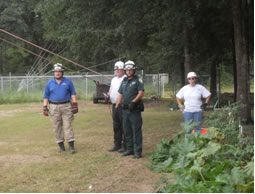 |
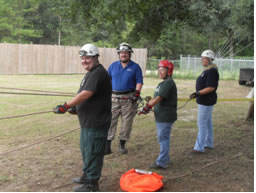 | 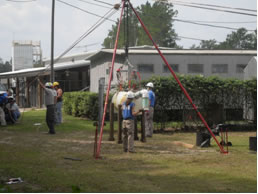 |
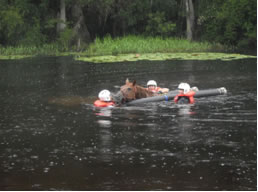 |  |
Module in Review
From the Florida SART training module "Should Hotels and Motels Welcome Pets in Disasters?" (www.flsart.org/library/petdisast.htm):
- What percentage of US homes have a dog? _____
- What percentage of US homes have a cat? _____
- Which of the below is not true about the benefits of keeping owners with their pets during an emergency? _____
- Owners can feed, exercise and clean up after their pets.
- Many pets do better with owners taking care of them.
- Pet-only shelters are labor-intensive, and adequate staff and volunteers may not be available in a large evacuation.
- All of the above are true.
Module prepared by: Laura Bevan, director, HSUS SE Regional Office, Tallahassee
with Chris Eversole and Carol Lehtola, University of Florida, Gainesville.
Quick Notes
Class Availability Reminder
AgERT classes in Alabama. AgERT dates for the balance of 2009 are October 19-24, November 15-20 and December 6-11. For registration information see http://cdp.dhs.gov. Contact Gordon Harman for information at Robert.G.Harman@aphis.usda.gov or (256) 231-5632.
Additional WIFSS courses in prevention of agroterrorism and food safety issues are on the drawing board for the final quarter of 2009. For information, check with the office of Art Johnstone at the Office of Agricultural Emergency Preparedness (850) 410-6758 johnsta@doacs.state.fl.us.
Most Hated Bird?
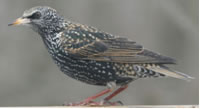
European Starling
A news-feature from the Associated Press recently referred to the European starling as the "most hated bird in America." Perhaps everyone knows the story of this non-native invasive's introduction and spread across North America - how a group in New York City brought to America every bird mentioned by Shakespeare - how in the 1890s about 100 starlings were released in Central Park - and how they spread in an irresistible wave across America, displacing native birds, surging into parks in vast numbers, bringing down the occasional airplane and becoming a real pest. No eradication and few control efforts have been successful. Thank goodness the bard of Britain didn't mention pterodactyls.
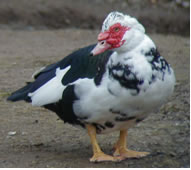
Muscovy Duck
For sheer pestilential-power-presence, however, the Muscovy duck would have to stand beside the starling. It is present in increasing numbers in every Florida body of water larger than an overturned teacup and contributes to fecal contamination of ponds and streams. The Muscovy is apparently a "sentinel bird" for avian influenza, becoming one of the first to drop dead when the disease is present. Typically, local regulations are passive about these invasives, simply requesting that individuals not feed them ... and not harm them. Although it is probably not possible to rid our lands and waters of these invasives, when it comes to Muscovy ducks one is tempted to root for Florida's home-boy, the reptile at the top of the food chain, our carnivorous alligator: "Live long and prosper."
Quick quiz - "ECO"
Joe Kight is Florida's designated "ESF-17 ECO." Do you know what "ECO" stands for? Is it:
- Emergency Contact for Operations
- Emergency Coordinating Officer
- does not stand for specific word options - is only a letter-set of Florida's emergency system
Remember SART's Mission Statement: "SART is a multi-agency coordination group consisting of governmental and private entities dedicated to strengthening all-hazard disaster capabilities through partnerships. Florida SART will support an effective and coordinated incident response for the animal and agricultural sectors in the State of Florida." So if you choose #2, give yourself one Attaboy!
[top]
About the SART Sentinel |
Editor: Rick Sapp, PhD, Technical Writer, Florida Department of Agriculture & Consumer Services, Division of Animal Industry [rsa5@cox.net] Associate Editor: Joe Kight, State ESF-17 Coordinator, Florida Department of Agriculture & Consumer Services, Division of Animal Industry [kightj@doacs.state.fl.us] The SART SENTINEL is an E-mail newsletter prepared monthly by Rick Sapp and the members of the Florida State Agricultural Response Team. Past issues of the Sentinel are archived on the Florida SART Web Site, www.flsart.org. If you have a story or photo that you would like to have considered for publication in The SART SENTINEL, please contact the Editors. |
[top]
